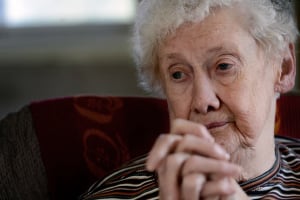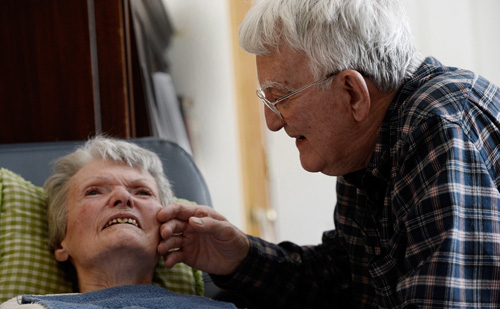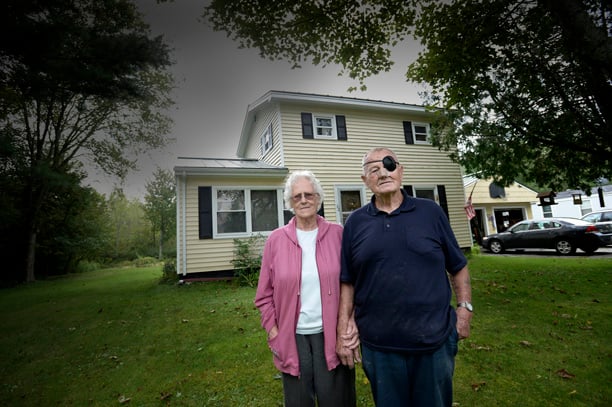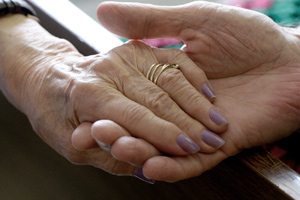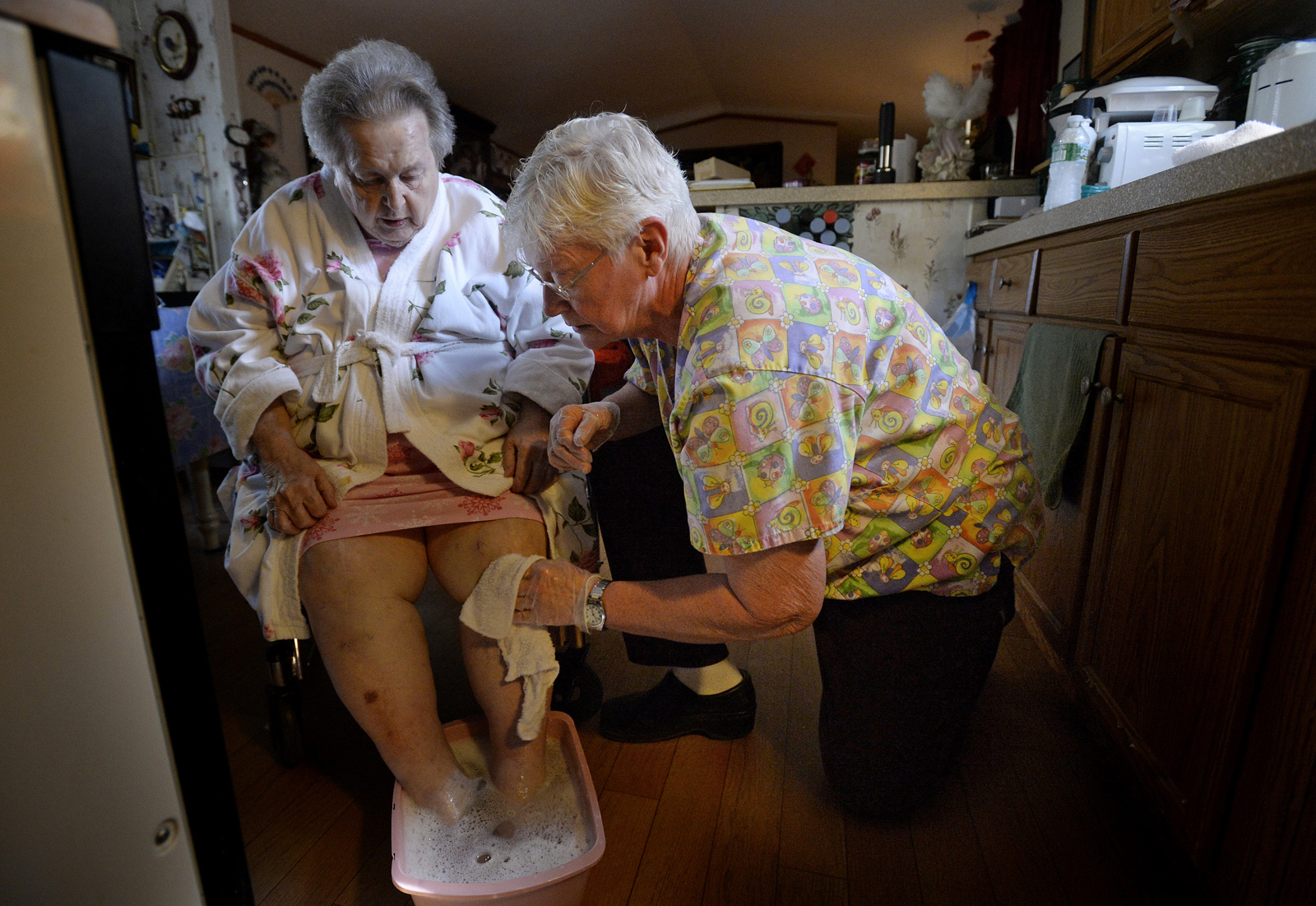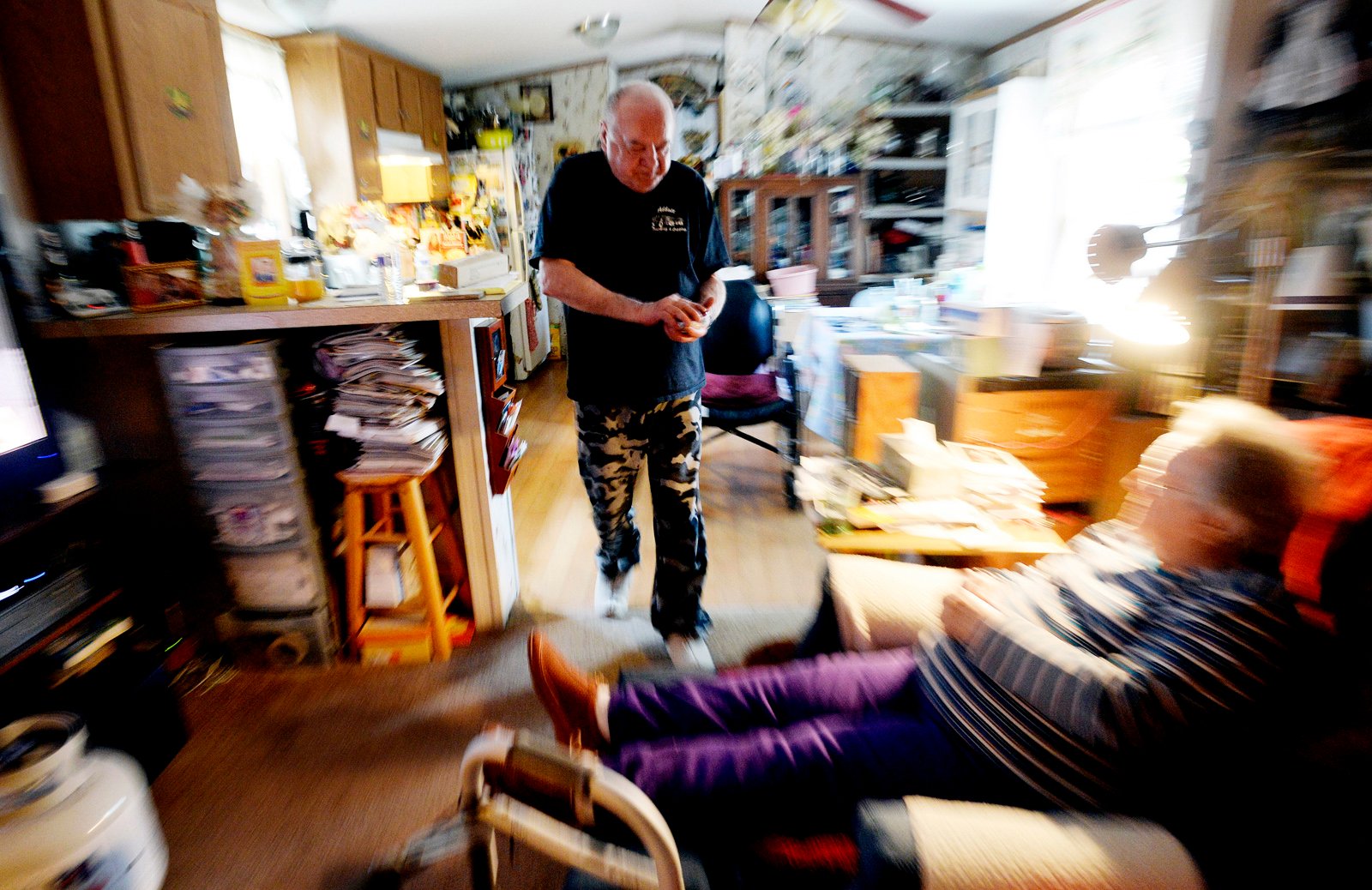W
INDSOR — Mildred Rood lets out a little sigh, relishing a moment’s relief from the near-constant pain and numbness that come with having neuropathy in her
feet.
A personal care attendant is rubbing medicated lotion on Mildred’s feet, after washing them in a pink plastic basin of warm water laced with sweet-smelling
soap.
“Does that feel good?” asks Nancy Boily, 65, kneeling before Mildred’s wheelchair in her cramped kitchen.
“Ohhh,” Mildred moans softly, “it always feels good.”
At 85, Mildred is homebound and largely confined to a wheelchair as a result of advanced diabetes, congestive heart failure and kidney disease.
Nancy Boily visits three mornings each week, helping Mildred with a variety of personal and home care needs, including bathing and toileting. It’s critical
assistance that allows Mildred, who is eligible for nursing home care, to stay in her modest mobile home on a dirt road in the woods near Augusta.

The former Mildred Parlin, right, is pictured with her siblings in this circa 1940 family photograph. Mildred Rood grew up in a family of 15 kids on a farm in Jefferson and raised her own family of four in Warren.
Copy photo by Shawn Patrick Ouellette/Staff Photographer
But while Mildred is authorized to receive daily care, she often goes two or three days without outside assistance, leaving her dependent on the care of an ailing son who lives with her. And Mildred is fortunate – about 1,200 Mainers are on waiting lists for similar services, and that number is expected to grow in the coming fiscal year.
That’s because home and personal care programs for about 6,800 low- and moderate-income seniors are seriously underfunded, home care advocates say. As a
result, there’s a statewide shortage of people who are willing to do such demanding, often difficult work for less than $10 an hour and no benefits.
Advocates blame state reimbursement rates that have been deficient and stagnant for more than a decade, despite the potential for significant savings if
the spending emphasis were tipped toward home care. MaineCare, the state’s form of Medicaid, spent an average $558 per month for each client who received
personal care services at home in 2010, compared to $4,150 per month for each nursing home resident during the same year, according to a 2012 analysis by
the Muskie School of Public Service.
Without intervention, the shortage of home care workers is expected to grow in a state with a rapidly expanding elderly population, a shrinking work force
and limited government resources that might be tapped to make tough jobs more attractive. Add a looming federal requirement that will force many small
businesses to provide employee health benefits in 2015, and some home care agency operators fear they may be forced to close altogether.
“We couldn’t provide the service anymore. We’d lose money,” said Stephen Farnham, executive director of the nonprofit Aroostook Area Agency on Aging.
Mildred Rood is one of an increasing number of Maine seniors who need home and personal care services through state-funded programs that aren’t keeping up
with current demand and aren’t prepared for the onslaught that’s coming. The growing need for senior home care is part of a worldwide demographic shift
that’s more acute in Maine, where the population is aging faster than the rest of the nation.
The state’s median age – 43.5 years – is the highest in the United States, in part because Maine also has a dwindling younger population, according to the
U.S. Census. The state’s proportion of people age 65 and older – 17 percent – is second only to Florida’s 18.2 percent.
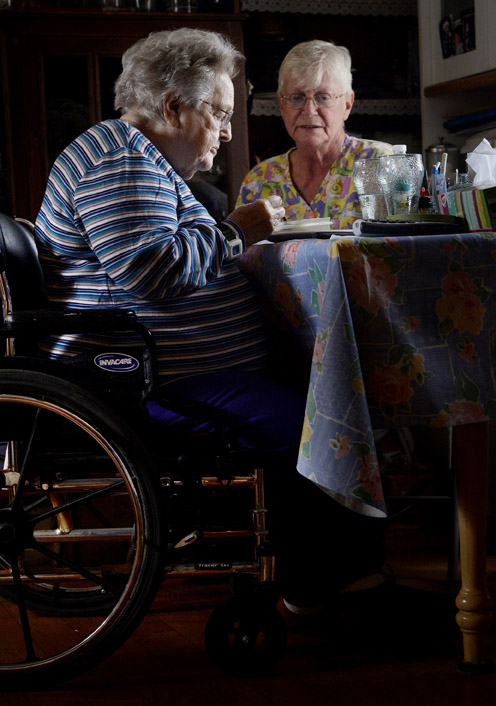
Nancy Boily, 65, a personal care attendant, sits with Mildred Rood, 85, as the older woman eats lunch during a recent home care visit to Mildred’s home in Windsor. “I get pure satisfaction knowing they’re getting the care that I would want,” Boily says. “I love my clients tremendously. I get enjoyment hearing them say, ‘Oh, you should be a nurse, you’re doing good.’ Mildred told me that one day.”
Shawn Patrick Ouellette / Staff Photographer
Maine also has the nation’s highest proportion of baby boomers – 29 percent of its 1.3 million residents were born between 1946 and 1964 – and they’re
turning 65 at a rate of 18,250 a year, according to AARP Maine. By 2030, more than 25 percent of Mainers will be 65 or older, and 52,273 of them will be at
least 85 – more than double the number of people in the oldest category in 2000.
Many agree that all long-term care services have been underfunded for years, including assisted-living facilities and nursing homes that accept MaineCare
recipients. But while the Legislature gave nursing homes a long-overdue funding increase this month, home care advocates say their sector isn’t getting the
attention it deserves as a much less expensive and often preferred option to institutional care.
“We’re always going to need nursing homes,” said Brenda Gallant, Maine’s long-term care ombudsman. “But home care is the direction the country is going
because people want to stay in their homes and it’s more cost effective. And we’re not going to be able to sustain everyone going into the highest levels
of care.”
Despite growing need, Maine lawmakers haven’t increased reimbursement rates for home and personal care services provided to low- and moderate-income seniors since 2004, whether funded through federally matched MaineCare or separately through the state’s general fund.
As a result, home care agencies struggle to find and keep dependable employees, largely because few people are willing to do such challenging work for
about $9.50 an hour without benefits or mileage reimbursement.
“They can flip burgers or work at Home Depot for the same or better pay and maybe get benefits and have a lot less stress,” said Mollie Baldwin, chief executive officer of Home Care for Maine, a Farmingdale-based nonprofit agency that employs about 550 home care workers and serves about 850 clients across the state.
PERSONAL SATISFACTION
Nancy Boily is one of Baldwin’s employees. Three mornings each week, Boily drives 16 miles from her home in Farmingdale to Mildred’s home in Windsor. She
must provide her own car but doesn’t get paid for mileage unless she’s running errands for a client. She gets paid for travel time only when she’s driving
directly from one client’s house to another. If she gets sick or there’s a blizzard, she doesn’t get paid at all.
Boily, a certified nursing assistant, says she gets $9.80 an hour. She’d like to make $15 – that’s the hourly rate she got once when she had a private-paying client. Home care workers whose clients have insurance or pay out of pocket can earn $15 to $30 an hour. Boily says a few extra dollars would help cover the cost of gas and keeping a car on the road. As a former military member, her health care is covered by the Veterans Administration. She can’t imagine how a single mom might make ends meet on her pay alone.
So why does she do it?
“I get pure satisfaction knowing they’re getting the care that I would want,” Boily says. “I love my clients tremendously. I get enjoyment hearing them
say, ‘Oh, you should be a nurse, you’re doing good.’ Mildred told me that one day.”
Some days it’s not so easy. Through the years, some clients have lashed out in anger or frustration.
“I have to separate my emotions from what the client is dealing with,” Boily says. “It can be a challenge for them, dealing with their limitations.”
But personal fulfillment wears thin for many who work in the Medicaid-funded home care field, where low wages, no benefits and high turnover are common
across the nation.
It’s an estimated $62 billion industry with about 1.5 million people providing home care to more than 5 million clients, according to William Dombi, vice
president of law for the National Association for Home Care & Hospice in Washington, D.C.
“Medicaid is one of the largest employers of low-wage workers without health care benefits,” Dombi said. “The country is properly focused on favoring home
care, but it’s not willing to fund it to provide a living wage for these workers.”
Stagnant reimbursement rates are common, Dombi said, with states typically paying agencies $11 to $16 an hour for Medicaid services, and workers getting
less than $10 of that amount. Agencies use the difference to cover a variety of administrative costs, including employee recruitment and training programs,
criminal background and driving record checks, workers’ compensation and unemployment benefits.
in their words
an interview with Mildred Rood & Nancy Boily
STAGNANT RATES
Maine’s reimbursement rate for home and personal care services has been stuck at about $15 since 2005, according to Mollie Baldwin of Home Care for Maine. She can recite the state’s reimbursement history by heart because she was the long-term care program manager for Maine’s Office of Elder Services from 1991 to 2007.
Actually, the last increase occurred in 2004, Baldwin said, when lawmakers raised the rate from $14.20 to $15.14, the highest it’s ever been. They lowered the rate to $14.98 in 2005, then it was bumped to $15 in 2010 to streamline accounting for the troubled computer systems at the Maine Department of Health and Human Services, Baldwin said.
“The reimbursement rate has never been based on the actual cost of providing the service,” she said.
A state-funded homemaker program administered by Catholic Charities Maine has a slightly better reimbursement rate of $18.75 an hour and serves about 2,400
elderly and disabled adults, but it has a waiting list of 1,080 people, said Don Harden, program director. His workers get $8.50 to $10 an hour.
Reimbursement rates for home health workers haven’t changed since 1999, Baldwin said. The per-visit rates are $89 for registered nurses and $39 for home
health aides. A typical visit takes 30 to 60 minutes, she said.
Long-term care experts say home and personal care services have the greatest potential to save money and keep seniors from entering assisted-living
facilities or nursing homes unnecessarily. And nearly 90 percent of seniors indicate that they want to stay in their homes as long as possible, according
to the AARP.
But without better funding, home care agencies increasingly struggle to attract and keep good workers, Baldwin said. In January, her agency processed 170 applications and hired nine people. Thirteen were rejected because they had criminal records; 18 wanted guaranteed hours the agency cannot promise; 34 didn’t meet some other requirement, such as having a high-school diploma, a driver’s license or a car with automobile insurance; and 44 didn’t call back or show up at some point during hiring process.
“It’s frustrating,” Baldwin said. “When I retired from the state and took this job seven years ago, I had this fantasy that I could make a difference being
outside state government. Initially, I think I did, but the money situation has gotten so bad now.”
GROWING SHORTAGE
The current worker shortage is expected to get worse as national and state labor officials predict high growth in the number of jobs for both home and personal care aides and for home health aides.
Looking ahead to 2020, the Maine Department of Labor anticipates 22 percent job growth for home and personal care aides, and 24 percent job growth for home health aides. However, the department said in a report this month that “strong demand coupled with low pay and high emotional and physical demands...may lead to shortages of workers.”
There were 7,030 home and personal care aides and 3,670 home health aides working in Maine in 2012, according to the report. They earned an average $17,370 and $19,310 per year, respectively. Some work for several agencies, with either public- or private-pay clients, to string together enough hours to make a living, home care advocates say.
According to the report, 93 percent of this full- and part-time work force is concentrated in Maine’s larger or most-populated counties, including
Androscoggin, Aroostook, Cumberland, Kennebec, Penobscot and York, leaving significant shortages in other counties.
Nearly half of these workers have higher-than-required education levels, which may contribute to high turnover, the labor department concluded.
But the biggest challenge may come from other higher paying jobs, especially in coastal communities that get summer infusions of wealthy seasonal
residents.
“We have a handful of workers in Lincoln County. The same is true in Hancock County,” Baldwin said. But come summer, many home and personal care workers can do the same work or get jobs as house maids for $25 an hour, she said, and many work “under the table” to make the most of their earnings.
“We can’t compete with that,” Baldwin said. She warns workers that they sacrifice Social Security or Workers Compensation benefits if they don’t claim
their earnings, “but to them, it’s worth it,” she said.
As the worker shortage intensifies and the senior population grows, Baldwin and other home care advocates worry that generational competition for
government resources will make it even tougher to get funding increases for home care programs. She’s also concerned that the growing divide between
seniors who have enough money to cover their long-term care and those who don’t will weaken the usually formidable influence of the 65-plus set on the
issue of publicly funded home care.
“We’d like to see some action on this soon because it’s not going to get easier,” Baldwin said.
RECENT LEGISLATION
In the last decade, the cost of MaineCare-funded long-term care services increased 33 percent, from $266 million in 2000 to $354 million in 2010, according
to an inflation-adjusted analysis by the Muskie School of Public Service.
During that period, nursing home expenditures increased 27 percent, from $186 million to $236 million, and state-funded assisted-living costs increased 116 percent, from $32 million to $69 million. However, spending on home- and community-based services decreased 4 percent, from $49 million to $47 million. The DHHS was unable to provide more recent comparable data
Some Maine lawmakers are aware of the challenges facing long-term care and are trying to address them.
In the current legislative session, nursing homes are on track to get an additional $4 million to $5 million for the next three years to help MaineCare
reimbursements cover the actual cost of care.
“We have an immediate crisis we need to take care of,” said House Speaker Mark Eves, D-North Berwick, noting that several rural nursing homes are in danger
of closing without an emergency funding increase.
That’s because MaineCare reimbursements to nursing homes are too low, falling $29 million short in 2011, according to the Maine Health Care Association,
which represents about 100 nursing homes and 100 assisted-living facilities.
The Legislature also approved an increase in reimbursement rates for adult day care programs, which help seniors stay with spouses or other family
caregivers, from about $9.40 to $12 an hour. Advocates say both funding boosts have enough bipartisan support to survive any veto efforts by Republican
Gov. Paul LePage.
But no one even asked for additional funding for home care services this session, though the need was raised during a recent statewide summit on aging
challenges facing Maine. And lawmakers dropped a proposal to create a blue ribbon commission that would study the long-term care spectrum, including home-
and community-based care, and recommend program and funding changes that would improve services and reduce costs.
Legislators will focus on home- and community-based services next, said Eves, who hosted the aging summit.
“We should be investing in community-based services to keep people in their homes, where they want to be, and where the cost of care is more affordable,”
Eves said.
Sen. Margaret Craven, D-Lewiston, hopes that the Commission to Study Long-term Care Facilities will be able to expand its scope as it continues its work in
the coming year.
“We felt like we haven’t even scratched the surface in looking at long-term care facilities,” said Craven, who’s a co-chairwoman of both the commission and
the Health and Human Services Committee.
“We can’t get a bigger bang for our dollar than with home-based care,” Craven said. “And when we delay these services to people, they wind up in assisted
living or a nursing home sooner than they should.”
SHORTSIGHTED DELAY
But some worry that lawmakers will continue to view long-term care programs in isolation and continue to favor nursing homes and assisted-living facilities
because they are the most organized sector with the highest costs and the most tangible needs.
And their needs are great. Because of chronic underfunding, 43 percent of Maine’s nursing homes and 41 percent of assisted-living facilities dependent on
MaineCare are in rundown condition and should be renovated or replaced, according to the Muskie School of Public Service.
“We really need to be looking across the board at the spectrum of long-term care to see what’s working, what’s not and what we need to be investing in for
the future,” said Jessica Maurer, executive director of the Maine Association of Area Agencies on Aging.
Home care advocates say it’s shortsighted to delay action because rebalancing long-term care spending in favor of home care will save money.
A delay also could be disastrous for many community-based programs, said Stephen Farnham of the Aroostook Area Agency on Aging. It already has been.
Farnham closed two adult day care centers in 2010 because they were losing money.
His fears his agency will have to stop providing home and personal care services, too, if the state doesn’t increase reimbursement rates before he’s
required to provide health benefits under the Affordable Care Act in 2015.
Farnham has about 100 full- and part-time workers taking care of 165 seniors. Providing health benefits would add about $3 to his hourly costs and
effectively put his agency out of business.
“It’s scary to think about, but that’s what I see,” Farnham said. “For many of our workers, it’s a labor of love, but we should be paying them better.”
Farnham figures he needs a reimbursement rate of $26 to pay his workers $15 an hour and provide health benefits, two weeks of vacation/sick time and
mileage reimbursement. That would push the average monthly cost of personal care services for a MaineCare client from $558 to $967, but that’s still a lot
less than the average $4,150 per month cost of nursing home care.
“I understand that any talk about expanding funding for anything is overwhelming for most legislators,” Farnham said. “But I truly think they don’t
understand the situation we’re in.”
LIVES AT STAKE
Mildred Rood grew up in a family of 15 kids on a farm in Jefferson and raised her own family of four in Warren. Married twice, she worked a variety of jobs
when she was younger, from washing linens at a nursing home to selling Avon cosmetics door to door. Collectible perfume bottles can be spotted among the
more than 200 dolls displayed in several curio cabinets that line the walls of her living room.
She was always independent, and fights to stay that way today, even after a fall three years ago stole her ability to walk on her own and landed her in a
nursing home. She didn’t want to stay there. After six months, she called her son, Bobby Perry.
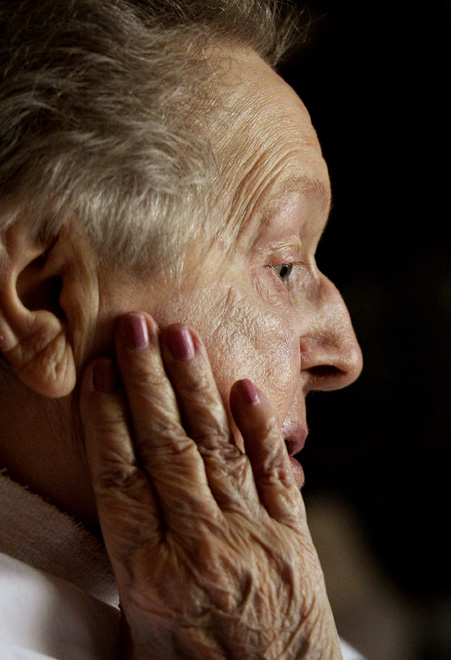
Mildred Rood is authorized to receive daily care, but she often goes two or three days without outside assistance. And she is among the fortunate; 1,200 Mainers are on waiting lists for similar services.
Shawn Patrick Ouellette / Staff Photographer
“I said, ‘I am going home,’ ” Mildred recalls. “I didn’t like being there at all. So he came and got me and took me home.”
But while Mildred is considered a high-need case and is authorized to receive 44.5 hours of personal care per week, she’s lucky to get 20 hours. Nancy
Boily, who visits her three mornings each week, has two other clients and already works about 40 hours per week. Baldwin’s agency has a difficult time
finding workers to fill the remaining slots, largely because she lives in a rural area, which requires unpaid driving time, but she’s near a city, which
offers competitive job opportunities.
If Mildred got all the help she needs, it would cost the state $2,890 per month – a lot less than the average $4,150 per month for nursing home care. Her copayment for the service is a flat fee of $100 per month, which she pays from her $1,300 monthly Social Security check.
Mildred isn’t the only one whose health is jeopardized by the lack of assistance. When no one shows up, it’s her ailing son, Bobby Perry, who helps her get
up, go to the bathroom, bathe and take care of other personal matters. He’s also responsible for the laundry, cooking and cleaning.
“He takes good care of me, but it’s getting so now that he’s sick himself,” Mildred says. “In February, I had 70 hours without (any outside help). That was
quite a long time. That (was very tiring for) him.”
A former chef and hotel manager, Bobby Perry has AIDS. Now 64, he’s been battling the disease for 27 years and it’s starting to get the best of him.
“Some days I’m just not well and the two of us are struggling to get through the day,” Perry says. “It just makes you want to cry sometimes, because I want
more for my mother. I want her to have a better life and some days I feel like I’m failing terribly.”
Perry says he understands that there’s a worker shortage and that the ones who visit his mother are underpaid.
“That doesn’t change the frustration level for me,” he says. “I’m getting sicker and I’m afraid she won’t have the care she needs and she’ll wind up in a
nursing home.”
Perry says his biggest concern is that he will die before his mother and that his siblings will be unable to care for her as he has.
“I promised her that as long as I’m alive, she’s not going to a nursing home,” Perry says. “But it’s getting to the point where I’m worried that I won’t be
able to keep my promise.”
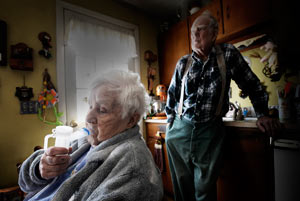
PART VI: ARNOLD & CORINNE MURRAY
Condition critical
Arnold and Corinne Murray have spent years navigating a healthcare system that’s not geared to the needs of the elderly. Their dizzying encounters with a string of doctors, hospitals and rehabilitation centers reflect the challenges of staying healthy in a state where the elderly population is exploding.

HOME & PERSONAL CARE
Home care guide
Several types of home care services are available to Maine seniors, ranging from housekeeping to assistance with medication and other basic health needs.

Further Discussion
Here at
PressHerald.com we value our readers and are committed to growing our community by encouraging you to add to the discussion.
To ensure conscientious dialogue we have implemented a strict no-bullying policy. To participate, you must follow our
Terms of Use.
Questions about the article? Add them below and we’ll try to answer them or do a follow-up post as soon as we can.
Technical problems? Email them to us with an exact description of the problem. Make sure to include:
- Type of computer or mobile device your are using
- Exact operating system and browser you are viewing the site on (TIP: You can easily determine your operating system here.)
